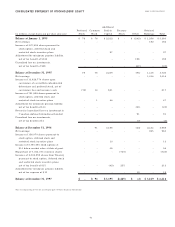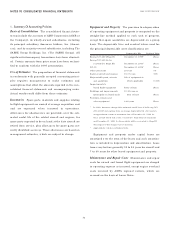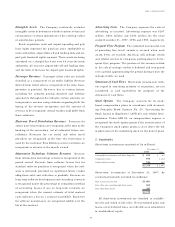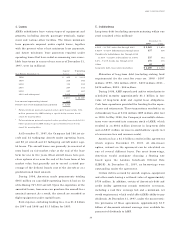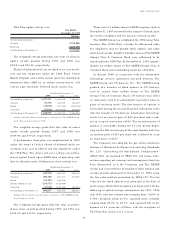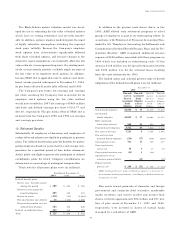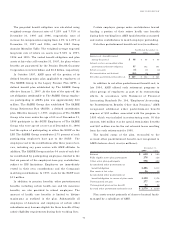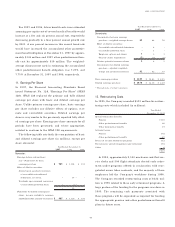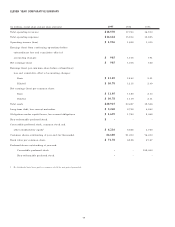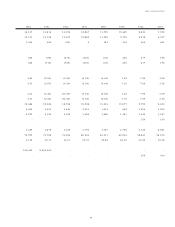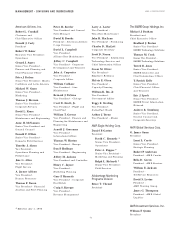American Airlines 1997 Annual Report Download - page 63
Download and view the complete annual report
Please find page 63 of the 1997 American Airlines annual report below. You can navigate through the pages in the report by either clicking on the pages listed below, or by using the keyword search tool below to find specific information within the annual report.
AMR CORPORATION
61
The Black-Scholes option valuation model was devel-
oped for use in estimating the fair value of traded options
which have no vesting restrictions and are fully transfer-
able. In addition, option valuation models require the input
of highly subjective assumptions including the expected
stock price volatility. Because the Company’s employee
stock options have characteristics significantly different
from those of traded options, and because changes in the
subjective input assumptions can materially affect the fair
value estimate, in management’s opinion, the existing mod-
els do not necessarily provide a reliable single measure of
the fair value of its employee stock options. In addition,
because SFAS 123 is applicable only to options and stock-
based awards granted subsequent to December 31, 1994,
its pro forma effect will not be fully reflected until 1999.
The Company’s pro forma net earnings and earnings
per share assuming the Company had accounted for its
employee stock options using the fair value method
would have resulted in 1997 net earnings of $960 million
and basic and diluted earnings per share of $10.77 and
$10.50, respectively. The pro forma effect of SFAS 123 is
immaterial to the Company’s 1996 and 1995 net earnings
and earnings per share.
10. Retirement Benefits
Substantially all employees of American and employees of
certain other subsidiaries are eligible to participate in pension
plans. The defined benefit plans provide benefits for partici-
pating employees based on years of service and average com-
pensation for a specified period of time before retirement.
Airline pilots and flight engineers also participate in defined
contribution plans for which Company contributions are
determined as a percentage of participant compensation.
Total costs for all pension plans were (in millions):
Year Ended December 31,
1997 1996 1995
Defined benefit plans:
Service cost - benefits earned
during the period $ 189 $204 $ 165
Interest cost on projected
benefit obligation 403 375 323
Return on assets (435) (91) (1,288)
Net amortization and deferral 26 (322) 1,008
Net periodic pension cost for
defined benefit plans 183 166 208
Defined contribution plans 142 132 124
Total $325 $298 $ 332
In addition to the pension costs shown above, in late
1995, AMR offered early retirement programs to select
groups of employees as part of its restructuring efforts. In
accordance with Statement of Financial Accounting Stan-
dards No. 88, “Employers’ Accounting for Settlements and
Curtailments of Defined Benefit Pension Plans and for Ter-
mination Benefits,” AMR recognized additional pension
expense of $220 million associated with these programs in
1995 which was included in restructuring costs. Of this
amount, $118 million was for special termination benefits
and $102 million was for the actuarial losses resulting
from the early retirements for 1995.
The funded status and actuarial present value of benefit
obligations of the defined benefit plans were (in millions):
December 31,
1997 1996
Plans with Plans with Plans with Plans with
Assets in Accumulated Assets in Accumulated
Excess of Benefit Excess of Benefit
Accumulated Obligation Accumulated Obligation
Benefit in Excess Benefit in Excess
Obligation of Assets Obligation of Assets
Vested benefit obligation $4,580 $ 53 $2,729 $ 1,435
Accumulated
benefit obligation $4,802 $ 57 $2,882 $ 1,510
Effect of projected
future salary increases 940 26 650 202
Projected benefit obligation 5,742 83 3,532 1,712
Plan assets at fair value 5,213 6 3,154 1,463
Plan assets less than
projected benefit obligation (529) (77) (378) (249)
Unrecognized net loss 761 27 729 237
Unrecognized prior
service cost 58 5 37 29
Unrecognized transition asset (21) 1 (32) -
Adjustment to record
minimum pension liability - (11) - (69)
Prepaid (accrued)
pension cost1$269 $ (55) $356 $ (52)
1AMR’s funding policy is to make contributions equal to, or in excess of,
the minimum funding requirements of the Employee Retirement Income
Security Act of 1974.
Plan assets consist primarily of domestic and foreign
government and corporate debt securities, marketable
equity securities, and money market and mutual fund
shares, of which approximately $92 million and $71 mil-
lion of plan assets at December 31, 1997 and 1996,
respectively, were invested in shares of mutual funds
managed by a subsidiary of AMR.


